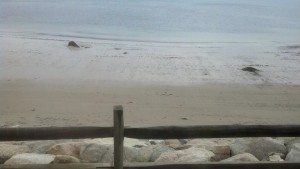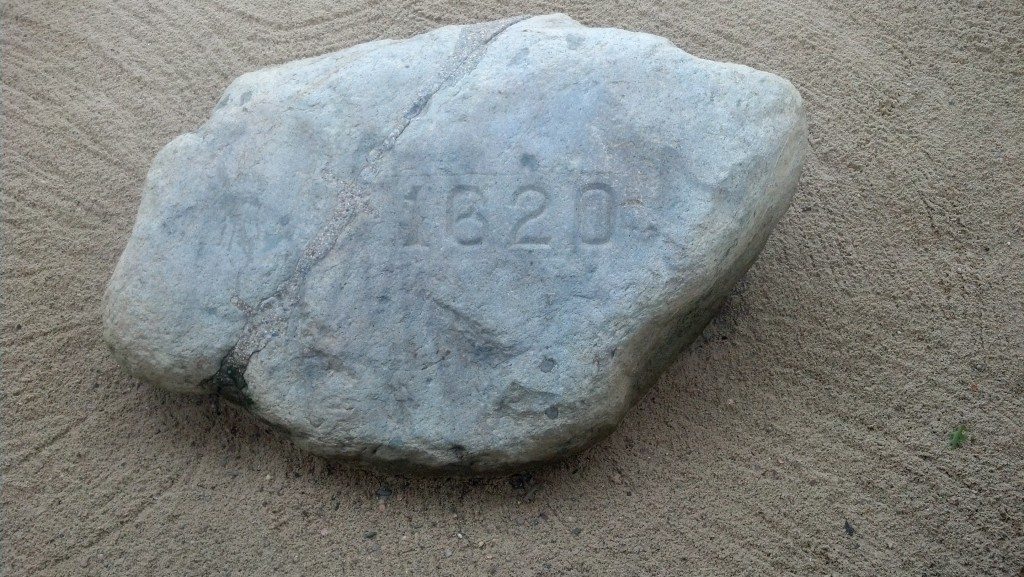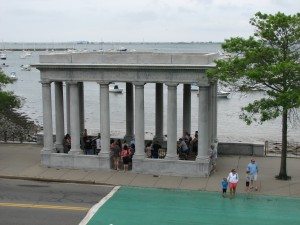 One of my strongest memories from middle/high school is driving in a bus for what seemed like days (probably about an hour) to go see Plymouth Rock. We’d been studying the pilgrims and were excited to see the spot, the very spot, where the first pilgrim set foot on America in 1620. We drove, we parked, we disembarked, we saw a large pavilion, we walked over, and there is was, a rock. I was shattered. I don’t know what exactly I expected of an attraction named “rock” but that certainly wasn’t it.
One of my strongest memories from middle/high school is driving in a bus for what seemed like days (probably about an hour) to go see Plymouth Rock. We’d been studying the pilgrims and were excited to see the spot, the very spot, where the first pilgrim set foot on America in 1620. We drove, we parked, we disembarked, we saw a large pavilion, we walked over, and there is was, a rock. I was shattered. I don’t know what exactly I expected of an attraction named “rock” but that certainly wasn’t it.
Today, I took the kids to “blog the rock.” A great opportunity to write about educational adventure with kids right? Over breakfast, Bill got out Wikipedia and I read a local brochure about the rock out loud. We devoured delicious pancakes and omelets as we learned about the following saga:
Traditional history tells that the Mayflower landed in Plymouth in 1620 and that the pilgrims first touched America as they stepped out onto a large rock. I always thought the ship actually ran into that rock but apparently the ship didn’t crash land. That’s good I guess. Wikipedia claims that the Pilgrims actually first landed toward the tip of Cape Cod in November 1620 before moving to Plymouth later. But wait, then what’s the rock all about?
Well, after the Pilgrims arrived, the rock went unexamined for years until the town was ready to build a wharf at Pilgrim’s Landing in 1741. At that time, a 94-year-old elder of the church named Thomas Faunce declared that he knew the exact rock onto which the first pilgrim stepped from accounts of the original Mayflower pilgrims. He identified this rock to an eager crowd some 121 years after the ship apparently landed (not crash landed) at Plymouth. The rock was not moved for another 3 years.
In 1774, the townspeople, excited about a revolution, decided to consecrate the rock but in the process of being lifted from its bed, the rock broke in two pieces. Since the giant rock had seemed unflawed, the break was taken as an omen that America and Britain would too separate. The upper piece of the rock was moved by oxen to town square. It again became anonymous and even part of an embankment. A town history was written, interest peaked again in the rock, and tourists started chipping away pieces for souvenirs in the early 1800s.
In 1834 they tried to move the rock to Pilgrim Hall and dropped it. It cracked. People kept chipping off bits. In 1854, they built another monument but had to cut off pieces of the rock to get it to fit inside. In 1880, they carved “1620” into it. In 1920, they moved it to its current home under the Billings canopy but they broke it again in the process and had to chip off more pieces to get it to fit back together.
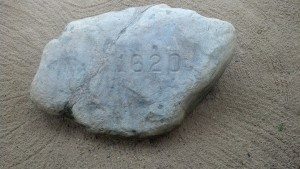 Now you can take a school bus or a minivan or even, as in our case, a rented Kia, and go see that piece of a rock that was probably near a spot where pilgrim’s moved after they first landed in America.
Now you can take a school bus or a minivan or even, as in our case, a rented Kia, and go see that piece of a rock that was probably near a spot where pilgrim’s moved after they first landed in America.
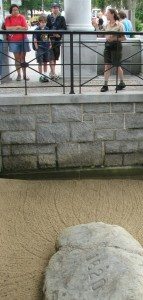 And what did my kids think? They were pretty entertained when they arrived to find a uniformed docent animatedly expounding the virtues of this rock. Yet, the rock itself still managed to disappoint. It was still small and still, well, just a rock. What had we expected? We laughed, we took photos, we bought cheap, tacky souvenirs made in China (something we usually try to avoid but it just fit the mood), and we learned a lot.
And what did my kids think? They were pretty entertained when they arrived to find a uniformed docent animatedly expounding the virtues of this rock. Yet, the rock itself still managed to disappoint. It was still small and still, well, just a rock. What had we expected? We laughed, we took photos, we bought cheap, tacky souvenirs made in China (something we usually try to avoid but it just fit the mood), and we learned a lot.
I know this post is a bit sacrilegious, particularly for a Bostonian, but really it’s a very silly monument of a very silly story. If you’re in the area, don’t miss the opportunity to discuss history and human nature while staring at a chip of a cracked rock. Do enjoy the beautiful beaches Plymouth has to offer and visit Plimouth Plantation to get a taste of real and interesting history.
